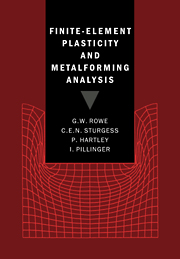Book contents
- Frontmatter
- Contents
- Preface
- Acknowledgements
- Nomenclature
- 1 General introduction to the finite-element method
- 2 Basic formulation for elastic deformation
- 3 Small-deformation elastic–plastic analysis
- 4 Finite-element plasticity on microcomputers
- 5 Finite-strain formulation for metalforming analysis
- 6 Implementation of the finite-strain formulation
- 7 Practical applications
- 8 Future developments
- Appendix 1 Derivation of small-strain [B] matrix for 2-D triangular element
- Appendix 2 Derivation of elastic [D] matrix
- Appendix 3 Derivation of elastic–plastic [D] matrix
- Appendix 4 Derivation of small-strain stiffness matrix [K] for plane-stress triangular element
- Appendix 5 Solution of stiffness equations by Gaussian elimination and back-substitution
- Appendix 6 Imposition of boundary conditions
- Appendix 7 Relationship between elastic moduli E, G and κ
- Appendix 8 Vectors and tensors
- Appendix 9 Stress in a deforming body
- Appendix 10 Stress rates
- Appendix 11 Listing of BASIC program for small-deformation elastic–plastic FE analysis
- Bibliography
- Index
3 - Small-deformation elastic–plastic analysis
Published online by Cambridge University Press: 22 September 2009
- Frontmatter
- Contents
- Preface
- Acknowledgements
- Nomenclature
- 1 General introduction to the finite-element method
- 2 Basic formulation for elastic deformation
- 3 Small-deformation elastic–plastic analysis
- 4 Finite-element plasticity on microcomputers
- 5 Finite-strain formulation for metalforming analysis
- 6 Implementation of the finite-strain formulation
- 7 Practical applications
- 8 Future developments
- Appendix 1 Derivation of small-strain [B] matrix for 2-D triangular element
- Appendix 2 Derivation of elastic [D] matrix
- Appendix 3 Derivation of elastic–plastic [D] matrix
- Appendix 4 Derivation of small-strain stiffness matrix [K] for plane-stress triangular element
- Appendix 5 Solution of stiffness equations by Gaussian elimination and back-substitution
- Appendix 6 Imposition of boundary conditions
- Appendix 7 Relationship between elastic moduli E, G and κ
- Appendix 8 Vectors and tensors
- Appendix 9 Stress in a deforming body
- Appendix 10 Stress rates
- Appendix 11 Listing of BASIC program for small-deformation elastic–plastic FE analysis
- Bibliography
- Index
Summary
INTRODUCTION
The methods described in Chapters 1 and 2 are generally applicable though the discussion so far has been related largely to linear elastic problems. In these problems the [D] matrix does not change during deformation and the changes in the [B] matrix due to the changes in nodal co-ordinates are small.
In plastic deformation, and especially in metalforming, the strains may be very large. A change of 30–40% in diameter of a drawn wire or height of a forging, for example, can often be required. In extrusion the strains may be much greater still, reaching logarithmic strains of 5 or more. This introduces very severe local distortion and we shall consider the problems involved later, in Chapters 5 and 6.
Even when the deformation involves only a small amount of plastic strain, the yield stress will change in a non-linear manner. The metal deforms elastically at first with essentially constant values of Young's Modulus and Poisson's Ratio, but as soon as the stress reaches the yield value, plastic deformation occurs with a much lower effective modulus. The yield stress itself increases with strain due to work hardening, and stress is no longer proportional to strain, but is related to the strain increment and, at least for hot working, also to the strain rate.
In this chapter, we shall consider only isothermal plastic deformation at temperatures such as the normal ambient, well below the range of hot working.
- Type
- Chapter
- Information
- Finite-Element Plasticity and Metalforming Analysis , pp. 40 - 48Publisher: Cambridge University PressPrint publication year: 1991

